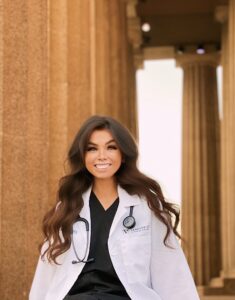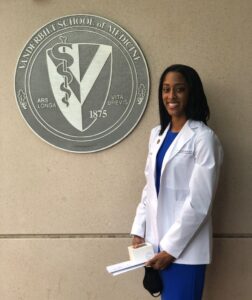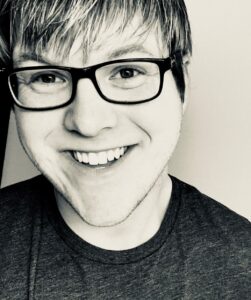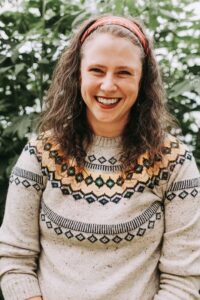VPIL teams collaborate, expand holistic approaches
The Vanderbilt Program in Interprofessional Learning (VPIL) combines approaches from medicine, nursing, pharmacy, social work, and counseling to inform student training and patient care
By: Lexie Little
In January 2016, Blair Miller, Pharm.D., of Vanderbilt University Health walked laps around her unit with a patient. She quizzed him about his medications: when to take them, how to take them, and how many to take. She had iterated these instructions in initial conversations, but she quickly realized this underserved, medically complex patient couldn’t read the written instructions on medication bottles. He would need to memorize the instructions before discharge. And she ensured he remembered.
Six years later, students in the Vanderbilt Program in Interprofessional Learning (VPIL) inform their practice through Miller’s example of compassionate, holistic care, aiming to understand not only the medical and pharmaceutical aspects of practice but the social effects of health care and the power of the health care team. Miller, one of 23 clinician preceptors in the program, leads a team of students for two years as they gain clinical and teamwork experience through this unique interprofessional education program. Teams feature a medical student, nursing student, pharmacy student, and counseling or social work student from Vanderbilt University and regional partners like Lipscomb University and the University of Tennessee College of Social Work.
VPIL teams spend one afternoon per week in a VUMC-affiliated clinic, seeing patients under supervision from preceptors from various health care professions, primarily physicians and nurse practitioners. Alex Miller Williams (medicine), Claire Dzierzak (counseling), Kyle McCurry (pharmacy), and Hayley Berry (nursing) serve patients at Vanderbilt Familiar Faces Clinic, which provides ongoing care for patients with complex chronic medical conditions. Often, these patients also live with socio-economic and other personal stressors that can markedly affect their medical outcomes.
Learning from each other
Before each clinic session, the team convenes with Miller to review notes about patients that she has hand-selected for them to see. In a single session, the team may see as few as six or as many as 12 patients. The students ask questions about each patient as they examine the last 24 to 36 hours of chart updates and notes.
“We are able to ask questions and clarify with Blair anything we’re not sure about before rounding,” Dzierzak said. “We each have very distinct interests within our professions, so she’ll say, ‘Oh, Alex, you might want to go see this person for this reason’ or ‘Hayley, you may want to go see this person for this reason.’ She does a good job of hand-picking people for us to see. We’ll team up in pairs and separate that group of 6-12 patients. Then, we go out and see them in clinic. We introduce ourselves when we see them, and we just open the floor for them to share with us things that have been going well with their care, things that they may have questions about – we try to get a better understanding of how well they understand their condition or what’s going on with them, both acutely and chronically, for a lot of our patients.”

When Hayley Berry hears Miller mention that Dzierzak might want to visit a certain patient, she jumps at the chance to go with her. Berry hopes to work with underserved populations after graduation from Vanderbilt University School of Nursing’s Family Nurse Practitioner specialty, and rounding with the future counselor gives her the opportunity to learn more about social factors related to health care and health care delivery.
Though Berry learned how to take a social history during her nursing coursework, she finds that VPIL and the opportunity to work with students from other professions has broadened her evaluations and capacity as a future provider.
“I learn about how to phrase questions and sense how a patient understands from Claire,” she said. “If a patient didn’t understand a question, instead of moving on for the sake of time, I now think about ways to rephrase the question so that they might understand. I’ve learned how to do a really thorough interview to get a lot of social context. As we’ve seen in our clinics, those are the main factors that affect their health outcomes. No matter what medications we prescribe, it’s really their context that matters. With pharmacy, we learn from both Blair and Kyle and the nuances to which they pay attention…I feel I’m a much better provider comprehensively because I can think, ‘Oh, what would Blair do?’ or ‘What would Kyle do?’ or ‘What would Claire say?’
“I’ve always been interested in working with underserved populations, and [VPIL] has given me such a unique experience. It has gotten me to the point where I feel like I can get to the root of a lot of problems… It has given me the ability to adequately and thoroughly serve the patients who need it the most. I cannot put into words how grateful I am for that experience.”
Informing future practice

Teamwork stands at the center of VPIL’s educational focus, but Alex Williams and her teammates also appreciate the learning that comes with working with the patient panel at the Familiar Faces Clinic. As she enters an exam room, she might see a patient with whom she worked months ago. She and her VPIL partners review prior notes they made, follow up on medications prescribed by the provider (a decision informed by the students’ conversations with the patient), and help sustain the patient-provider relationship so critical to addressing complex medical conditions.
Now in her second year as a medical student at Vanderbilt University School of Medicine, Williams appreciates the opportunity to learn from peers and patients alike.
“The patient population is something I haven’t seen in some of my other activities in school,” Williams said. “We see really socially complex patients on one hand, and I’m getting to learn a lot about how that plays into an individualized medical plan. On the other hand, there are medically complex patients with diseases I’ve never heard of until VPIL. Getting exposure to working with those patients and those diseases has been a great experience for me as a future physician. The longitudinal nature of VPIL is also unique…I’m on clerkship rotations now, so I am on one team for a maximum of two weeks in that educational setting. But with VPIL, we come to the clinic for two years. We’ve seen patients one week, then again three months later in some instances. That’s something that you don’t get much of while you’re in medical school, so I’ve enjoyed that aspect of VPIL.”
As an aspiring anesthesiologist, Williams realizes the importance of thorough histories and follow-ups, noting that she will need to pay particular attention to pharmacology reports in determining appropriate anesthetics and dosages. She cannot imagine her future career without interprofessional care teams, the context under which she will undoubtedly practice.
During her clerkship rotations at Vanderbilt University Medical Center, Williams visits patients with teams of resident and attending physicians and fellow medical students. Many times, the physicians will ask the nurses to present updates on a patient’s status and provide guidance on the patient’s condition from the nursing side of the care plan. But VPIL takes training a step further, allowing her to work not only with a nursing student, but with a counseling student and pharmacy student.
Connecting past lessons with future possibilities

Kyle McCurry has worked in pharmacy for almost 12 years. Currently a second-year student at Lipscomb College of Pharmacy, he informs his patient encounters based on experiences in both inpatient and retail pharmacy practice. He last worked in the emergency department as a medication reconciliation technician, asking admitted patients what medications they used (if any) and entered them into the electronic health systems to research what medications to prescribing providers should hold, what to continue, and what might interact with or contradict a new treatment plan.
He worked with many nurses and physicians in the ER, learning the value of collaborating with an interprofessional team. He defines the relationship between professionals through a unique metaphor: the cheese model.
“I think about it as a cheese model,” he said. “With an interprofessional model, it allows us to go from like a Swiss cheese with some little holes here and there in practice to Kraft Singles without any holes and with good, processed density. Care must have all of these other people involved because while we all bring such unique gifts, having us all there is what makes our patients safe [and fills in the holes]. If you’re having an off day and something on the chart just slips notice, it’s vital to have someone to say, ‘What about this?’ It’s a great way to learn. That’s not to say errors don’t happen, but when you have different people looking for different aspects of health, you address areas that one person alone might not notice or might not understand as well.”
After the team sees patients, they reconvene to debrief with Miller. They reflect on how each profession might have approached different information, seeking to find important context that might have otherwise been missed. They ask each other questions and think critically about notes to make on their patients’ charts for the full-time care teams, informing future care.
Reflecting on a holistic experience
VPIL student teams spend their second year in the program on their Capstone Project, in which they identify an aspect of practice in their clinic that could be improved, develop an intervention designed to make the improvement, and measure whether improvement was achieved. Their time in VPIL comes to a celebratory end with the presentation of each team’s academic poster about their Capstone Projects. As their time as a team draws to a close, Dzierzak, Williams, Berry, and McCurry reflect on what this experience means to them and to their careers.

As Dzierzak meets patients and caregivers, she thinks about their roles as experts in the room. While her teammates each specialize in a different area of health care, patients and their caregivers also bring crucial perspectives to the interaction. The caregiver at home with a chronically ill patient knows care routines, prior medical complications, and the patient’s personality, all of which inform care plans. And patients know the most about their own feelings and circumstances.
Dzierzak, also a psychotherapy intern at the Osher Center for Integrative Medicine at Vanderbilt as part of her counseling training program, now reframes her conversations to focus on the “inter-” aspect of interprofessionalism.
“I have always been someone who thinks I have something to learn from everyone that I meet, and this program has solidified that,” she said. “In different contexts, we could focus less on the ‘professional’ part and think about the ‘inter’ aspect. We have our patients, and that is also an interprofessional relationship that will better help us serve that individual…The focus of VPIL has shown me the fruit of the idea that I have something to learn from everyone. What everyone contributes is going to help the patient’s health and how we treat future patients with similar circumstances. As a counselor, I will never be an expert on a single patient, but patients are experts on themselves. That is professionalism in that setting to an extent – the patient is an expert in that context.
“In our clinic, too, we have had the privilege of being connected with the folks that are the caregivers of our patients…Family members care for their parents, siblings, children, spouses as if they are professionals, but they’re not getting paid. They’re the active caregivers in that scenario and important parts of our care teams in those support environments.”
All four team members credit Miller, their VPIL preceptor, for her strong leadership in making sure each person – student and patient – understands the nuances of patients’ medical and social circumstances. She has taught them to care for individuals while working as part of a collaborative unit, an experience Williams wishes each medical student were required to have as part of their professional development and that Berry regards as an essential part of her growth as a provider.
“I get to see how each piece of the interprofessional puzzle is absolutely essential to supporting those patients to improve quality of life and hopefully prolong life where we can,” Berry said. “I think I’m taking this perspective of ‘I might not always have an interprofessional team with me depending on where I work, but I have at least learned so much from my team members that I feel like I can be more holistic in my care and assessments that go beyond a basic social history.’ I really hope to go into diabetes management with rural populations and preventative care. Knowing all of these aspects of health care now is really going to help me be a better provider in that context in the future.
“I would say with confidence that this was the best thing I did for myself professionally.”
An experience they’ll truly remember – experience they will take to their professional practice each day – thanks to Miller and each to other, once and always their VPIL team.